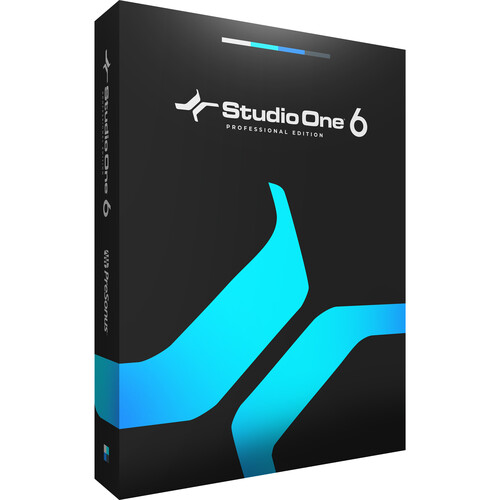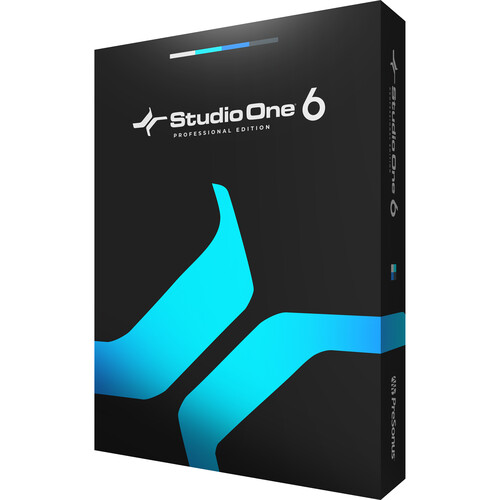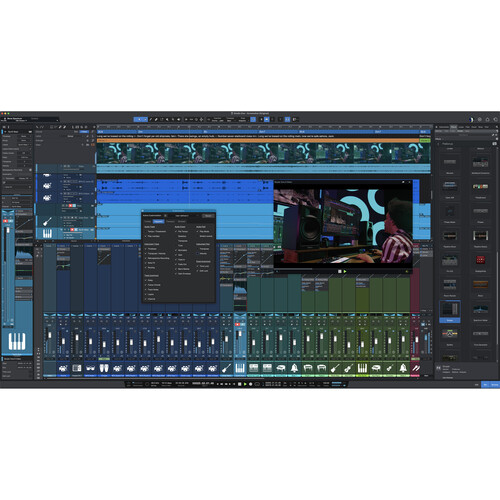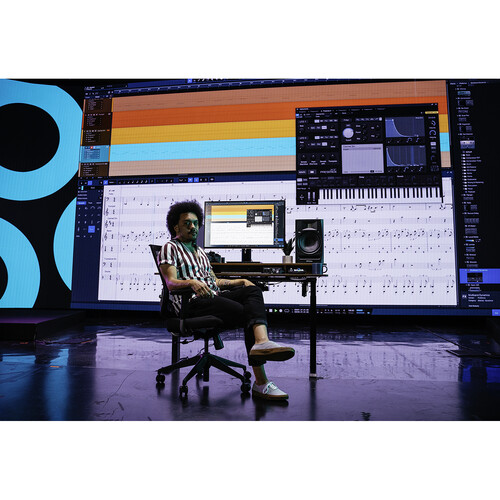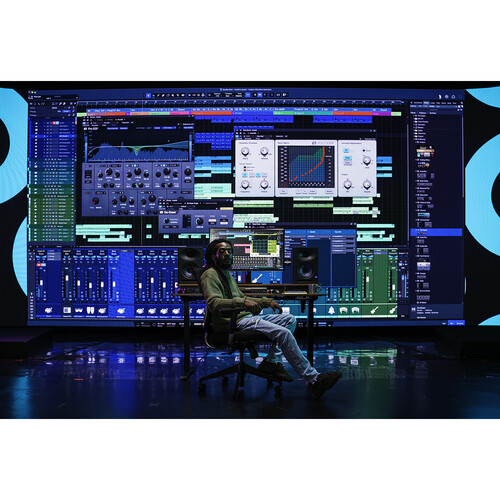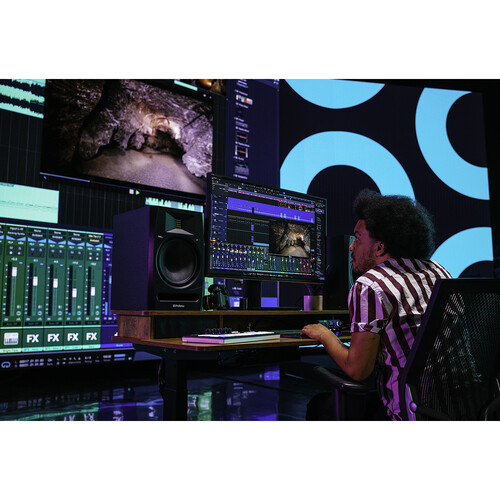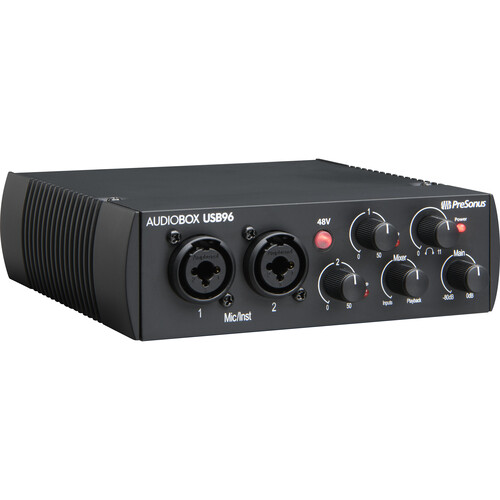PreSonus Studio One 6 Professional and Notion 6, Music Production and Notation Software (Educational Unlimited Site License, Download)
- Educational Unlimited Site License
- Compose, Produce, Perform, Mix & Master
- Score View, Show Page & New Plug-In UIs
- Up to 64-Bit / 384 kHz Resolution
- Unlimited Audio/MIDI/VI/Bus/FX Channels
- Notion 6 Notation Software
- Create Notation, Tablature, Lead Sheets
- Score Playback with London Symphony
- Audio Units, VST, VST2, VST3, ReWire
- macOS and Windows
guaranteed safe checkout

Academic institutions looking for music production software with powerful notation capabilities will be thrilled with the PreSonus Studio One 6 Professional + Notion 6, a complete unified solution for music production and scoring. From composing, producing, and recording, to mixing, mastering, distribution, and performing, this killer combination has what you need to get up and running in no time.
PreSonus Studio One 6 Professional offers a complete unified solution for music production, from composing, producing, and recording, to mixing, mastering, distribution, and performing. Featuring a flow-oriented drag-and-drop interface, the software is built for intuitive use, speed, and efficiency. This latest version provides numerous updates and upgrades including a new customizable user interface, smart templates, a global lyrics track, a global video track, track presets, and an advanced collaboration with PreSonus Sphere, plus all-new De-esser and Vocoder plug-ins, updated ProEQ, fader flip, binaural/dual pan modes, and more.
Studio One 6 Professional is robust enough for the most complex productions, delivering full audio and MIDI recording and editing capabilities, a comprehensive mastering suite, and built-in online cloud services. There are no limits on track count, plug-in instantiations, or editing features. Perfect for Mac- and Windows-based production systems, Studio One 6 Professional is compatible with any ASIO, Windows Audio, or Core Audio compliant audio interface, including the entire line of PreSonus interfaces.
- Mai Tai, Sample One XT, and Presence XT now offer support for compatible controllers to modulate individual notes in a chord independently using Poly Pressure (polyphonic aftertouch) or MPE (MIDI Polyphonic Expression). In Mai Tai and Presence XT, pitch, pressure, and timbre are available as modulation sources inside the modulation matrix, allowing these to be routed to any available destination. In Sample One XT, the pressure parameter is connected to the AMP and Filter. The amount can be controlled with a knob.
Browser Favorites and Folders
- Studio One’s innovative browser gets even better in version 6. Organize plug-in and instrument presets into custom folders that you can create right inside the browser. Presets for plug-ins and virtual instruments can now be marked as Favorites. Presets marked as Favorites are automatically mirrored inside a new Favorites folder at the top of the respective preset list.
Start Page
- Studio One’s Start Page is now even more flexible. Organize your Songs, Projects, and Shows into custom folders, allowing you to put all the files associated with a single artist or production in one convenient location. Pin favorites documents and view all your shared PreSonus Sphere documents in a single folder. Producers and mixing engineers working with multiple artists can now manage and create a unique Artist Profile preset for each client. Each profile includes name, genre, website, and an image—all of which are embedded as ID3 tags when exporting a mixdown for streaming or digital download.
Other Notable Additions
- Sends on FX Channels, allowing the output signal of one effect to be sent to another
- Sidechain audio input for virtual instruments
- Bus, FX, and Cue Mix sends now have the option to link panning to the channel pan control. Cue Mix sends provide independent link options for Volume and Pan
- Micro view controls for third-party plug-ins
- Track and Channel Icons
- Spot option for Events offers a number of options for positioning Events on the timeline based on event attributes such as start/end points or their original timecode position
- Tame vocal sibilance and other high-frequency sounds with the new De-esser. The De-esser in Studio One is efficient and intuitively easy to use. Find the problematic frequency with the Listen button, then dial in the amount of S-Reduction using the associated knob together with the S-Mon function. Choose between narrow and wide shapes for the reduction band, as well as gentle (-6 dB) or full (-48 dB) range gain reduction. The included presets are excellent starting points for customization.
Vocoder (New)
- Expanding Studio One’s set of creative custom plug-ins, the new Vocoder is a creative playground like no other that lets you combine two input signals to create an entirely new sound processed by an array of bandpass filters. Turn your voice or any audio source into a unique synth or effect. Vocoder will inspire you to play with audio.
ProEQ3 (Improved)
- The latest incarnation of ProEQ delivers two new powerful features, making it an indispensable tool for producers and mixing engineers. Each frequency band can now be soloed, so you can easily hear even the most surgical adjustments in isolation. In addition to solo, each band now features a dynamic mode to trigger boosts or cuts of the desired frequency band dynamically based on a set amplitude threshold.
Autofilter (Improved)
- The popular Autofilter plug-in has been updated to offer several useful enhancements including independent Attack and Release controls for the envelope and a Flip option to invert the modulation phase in the LFO section.
- Virtual instruments (VST2, VST3, AU) like samplers and vocoders that require an external audio source now have access to any audio source within the mixer using a side-chain input. Similar to FX plug-ins with a side-chain input, the sidechain signal can be routed conveniently from the source or destination. Aux Channels may be used to route external audio signals to a virtual instrument using a side-chain.
Advanced Mixer with Fader Flip
- Studio One’s Console supercharges mixing with the new Fader Flip. Control FX/bus sends, side-chains, and Cue Mix sends all from the main faders. Fader Flip is easy to access, too. Just right-click on the desired Send and select Flip. Now the entire send mix for the selected bus can be controlled from the channel faders. Unassigned channels can be hidden from view or activated as needed.
Alternative Panning Modes
- Stereo channels now feature a choice of pan modes. You can choose between balance, dual, or binaural panning for any stereo channel. The new panner pop-up editor provides a large pan control, a context menu to switch between modes, plus dedicated controls for each mode. The basic balance control remains available in all mixer views, as well as a standard pan control for external hardware controllers.
Mixer Channel Overview
- The new Channel Overview provides a single, consolidated view of all channel parameters, including input controls, inserts, sends, and Cue Mix sends for the selected channel. This view is available as a new tab in the Channel Editor window, which can be pinned anywhere on any screen and follows the channel selection. Channel Overview is an ideal way to work on the sound of a single channel quickly and intuitively across multiple plug-ins without having to open a dedicated plug-in editor.
- Only Studio One's Chord Track lets you create, audition, and change chord progressions in both audio and MIDI. It has never been easier to prototype a Song so quickly and simply - and keep your creative spark alive.
Drum Editor
- Studio One features an innovative streamlined Drum View to edit drum parts as fast as you can think. Drum View lets you name pitches by instrument and, with one click, hide any pitch not used for drum notes, creating a much cleaner look for drum parts that’s easy on the eyes and much clearer for editing.
Drum Notation
- Create drum notation using Studio One’s Score View. The drum map interface lets you add both the drum and note name to a corresponding notated pitch. A special preview window lets you drag each intended pitch up or down. You can even add a custom notehead and drum technique.
Live Arranging
- Stay in the moment while performing with backing tracks using the Arranger Track on the Show Page. Experiment on the fly while you're on stage or streaming live with five playback modes available on a per-section basis: Continue, Stop at End, Skip, Loop, or Loop and Continue.
Multi Instruments
- A Multi Instrument is a stack of multiple Virtual Instruments on a single Instrument Track that can be played, recorded, and edited as a single Instrument. A Multi Instrument can be key-split or layered, and offers full control over keyboard and velocity zones—plus powerful Note FX routing options.
Notation Dynamics and Articulation Marks
- Composers can add dynamics and articulation marks to their scores using familiar notation symbols—virtual instruments will respond with the appropriate performance. Dynamics symbols are tied to MIDI velocity, with customizable values.
Note Controller Support
- Studio One supports note controllers that can affect individual notes rather than the entirety of a track. With compatible MIDI controllers, you can use polyphonic aftertouch and MPE (MIDI Polyphonic Expression)
Notion Integration
- Studio One’s Score View provides powerful notation features. But when it’s time to get serious, you need real notation software, and that’s where award-winning Notion comes in to help. Send note data right from Studio One to Notion to create lead sheets and printed scores.
- Studio One features advanced key-switch integration for your favorite orchestral libraries and other virtual instruments. Key switches are filtered and excluded from playback processing, so you can take advantage of Note FX and Chord Track while still using your favorite articulations.
Aux Channels
- Studio One lets you incorporate your favorite hardware synths into your digital productions as easily as virtual instruments thanks to Aux Channels. Aux Channels feed any external audio into the Studio One Mixer without having to create an Audio Track that clutters your session.
Channel Visibility Filters
- Improved—The Console Channel List provides a variety of visibility filters, so you can adapt the Console to the aspects of the Song relevant to your current work. Filter options include: Audio Channels, Instrument Channels, FX Channels, Bus Channels, VCAs, and Aux Channels.
Harmonic Editing
- Studio One’s groundbreaking Harmonic Editing lets you change pitch in both polyphonic audio and MIDI. When inspiration strikes, you won’t need to rerecord a bassline or guitar riff just to try a chord substitution — place your new chord in the Chord Track you’ll hear it applied instantly, in the in the context of your existing Song. Best of all, Harmonic Editing is non-destructive, so you’re free to play.
Note Actions
- Note-editing options are at the heart of MIDI editing in Studio One. The Note Actions menu offers fast intuitive editing and composition and includes creative note-editing options for Instrument Tracks, including Randomize, Apply Scale, Mirror, and more. All of these are assignable to keyboard shortcuts and included in macros.
Note Repeat
- Fully remote-controllable from any MIDI controller, Note Repeat has its own section in the Record Panel where you can activate/deactivate it, quickly switch between different note values, and activate/deactivate Note Erase. Set the gate time for notes and use key or poly pressure to control note velocity.
Patterns
- Get step sequencing fast with Studio One‘s Patterns. Patterns are perfect for step programming and changing variations on the fly. Even better, Patterns are playable, real-time sequencers. You can change every parameter on a per-step basis—including 10 levels of repeat for strummed effects, probability controls, and Automation Lanes. Once the Pattern is complete, click and drag its edge to extend the Pattern for as long as you want within a track.
Prerecord
- Mistakes happen. The opening notes of a singer’s first perfect performance of the day may get missed because the engineer forgot to hit Record, or maybe you just missed the punch-in. Those mistakes can be embarrassing but what happens in Studio One stays in Studio One.
- Studio One features an innovative, streamlined Drum View to edit drum parts as fast as you can think. Drum View lets you name pitches by instrument and, with one click, hide any pitch not used for drum notes, creating a much cleaner look for drum parts that’s easy on the eyes and much clearer for editing. Combined with Impact XT and hundreds of preconfigured pitch names and mapping scripts available free from PreSonus Exchange, the new Drum Editor is like an accelerator for drum editing.
Drum Notation
- Create drum notation using Studio One’s Score View. The drum map interface lets you add both the drum and note name to a corresponding notated pitch. A special preview window lets you drag each intended pitch up or down. You can even add a custom notehead and drum technique. A General MIDI drum map preset is included as standard to provide a time-saving starting point for naming and mapping your favorite drum libraries to begin creating your own custom drum map collection.
High-Resolution Note Editing
- Studio One works with all the standard MIDI gear you know and love, from controllers to tone modules. But once MIDI data arrives into Studio One, it’s converted to a high-resolution, 32-bit internal format, which makes it ready to support high-resolution MIDI 2.0. That means no zipper noise on instruments, smoother controller changes and pitch bends, more detailed automation, and more.Note Controller Support
- Studio One supports note controllers that can affect individual notes rather than the entirety of a track. With compatible MIDI controllers, you can use polyphonic aftertouch and MPE (MIDI Polyphonic Expression).
Note Editor
- Studio One’s piano view Note Editor is instantly familiar to anyone who has worked with MIDI—perfectly intuitive to those who haven’t. A MIDI controller can be used to input notes traditionally or via Step Entry mode, and several tools support note entry and editing via mouse.
Side-By-Side Editors
- View your tracks in different editors side by side. Multiple editor windows in Studio One can now be detached from the main window and positioned freely, including on separate monitors. Similar to plug-in windows, the detached Edit windows can now be pinned to lock their view state.
- Studio One provides the highest-resolution audio production and mastering, thanks to its support for 64-bit floating-point WAV format—the recommended recording format for audio interfaces with 32-bit resolution. With this format option, the maximum recording and processing precision now reaches 64-bit / 786 kHz. When resolution matters, choose Studio One.
ARA 2.0 Support
- Give those pitchy vocals a gentle nudge closer to home, revoice or harmonize vocals, tune that bass, or create extreme vocal effects using Celemony Melodyne, Antares Auto-Tune Pro, Synchro Arts VocAlign, ReVoice Pro, and any other audio manipulation plug-in that supports ARA 2.0. Studio One and Celemony developers worked together to develop this ground-breaking technology and as a result, no other DAW is as seamlessly integrated with Melodyne, making Melodyne's tempo and chord detection available directly to the respective Tempo and Chord Tracks.
Audio Clip Versions
- Create new versions of audio clips to add more creative freedom to clip-based editing. Use multiple versions of a clip that references the same audio file and try alternative edits with Melodyne, Bend Markers, or Gain Envelopes, to dial in just the effect you need.
Comping
- Studio One's Comping tools make the once-tedious task of assembling a perfect take simple, efficient, and fun. Simply set up some loop points and record take after take without ever stepping out of your groove. When you've built up enough layers, use the Range Tool to promote the best parts to your main track. You've got a perfect take, and all you had to do was press the Record button and jam for a few minutes.Multitrack Drum Editing
- When it comes to multitrack drum editing, Studio One provides a robust suite of tools and features, including grouping, guide tracks, transient detection, and various slicing and time-stretching methods—all inside the convenient Audio Bend Panel. It's like having your own personal rhythm investigator on the job.
Notation Dynamics and Articulation Marks
- Composers can add dynamics and articulation marks to their scores using familiar notation symbols—virtual instruments will respond with the appropriate performance. Dynamics symbols are tied to MIDI velocity, with customizable values.
Smart Tools
- The combination of the Arrow and Range Tools boosts your audio editing efficiency by combining the most frequently used tools into one. Select, move, split, or duplicate Events; trim start- and end-points of Events; adjust fades; and change the overall Event level in one seamless action. Studio One’s smart tools change dynamically to stay in the moment with you.
Spot
- Place your Audio and Note Events precisely where you want them with the Spot command. You can position Events on the timeline based on event attributes such as start/end points or their original timecode position. Spot is perfect for sound design and music to picture as well as working with stems in Studio One.
Time Lock / Edit Lock
- Studio One helps you to prevent unintentional edits—or worse, accidental timeline movements—with Time Lock and Edit lock. Individual Audio Events, Audio Parts and Instrument Parts in the Arrangement window can be Time Locked to prevent unintentional moving or Edit Locked to prevent unintentional editing.
- When you need more than a simple temporary group to raise or lower the level of several channels at once, Studio One has you covered with a powerful edit-and-mix grouping system. Groups can be nested (great for drums), named, colored, and assigned to keyboard shortcuts for enable/disable.
Cue Mix
- Cue Mixes let you create monitor mixes quickly and easily, right from the Console. Cue Mixes can now be flipped to the main Console faders to quickly dial in a complete mix. By default, Cue Mixes mirror the main mix on a per-channel basis, making it simple to adjust.
Easy Side-Chain Routing
- Every Studio One Native Effects dynamics plug-in has easy side-chain routing, so you can get the sound you want without routing headaches you don’t need. Side-chain routing can be controlled both to and from the plug-in with one click.
Mix Engine FX
- Add all the grit and character of the world’s most sought-after analog consoles to your Studio One Mixes with Mix Engine FX. Unlike conventional plug-ins that can only process a single channel or bus output, our proprietary Mix Engine FX technology affects your music across all channels.
Mixer Scenes
- Mixer Scenes are complete Mixer snapshots and can be saved at any time and recalled in their entirety, or filtered to only include volume, pan, mute, inserts, sends, cue mix settings, input controls, or any combination of these. Store and recall entire Mixer Scenes, Groups, or just a single Channel.
Pipeline XT
- Pipeline XT makes using analog processors as easy as adding a plug-in. Pipeline XT manages the signal flow to and from the external processor. Use the Auto button to measure and compensate for latency automatically. Then, use the Offset parameter to make manual adjustments.
Pop-Up Faders
- Pan and both FX Sends and CueMix Sends have convenient pop-up-faders, providing an enlarged version of the level and pan faders for improved accessibility and fine adjustments.
Splitter
- Splitter is a powerful plug-in that lets you route multiple simultaneous effects on a single channel in a myriad of ways: serial, parallel, or split by channel or frequency band. Simply drag a new Splitter plug-in from the Browser to any Insert slot to split its signal path.
Tempo Track and Tempo Detection
- Edit tempo with Studio One’s familiar automation tools for smoother tempo adjustments and custom curves. Map tempo manually to any imported audio or loop or use Melodyne to detect the tempo of an off-the-grid performance automatically. Once the tempo is detected, drag the audio to Studio One’s tempo.
Track and Channel Filters
- Studio One makes managing large projects with huge track and channel counts fast and easy, thanks to powerful search and filter options. Filter Tracks by typing text or use the filter options: Show All Tracks, Show Tracks with Events Under Cursor, and more.
Unlimited Everything
- Studio One doesn't place any artificial boundaries on your mixing and production workflow. Use as many audio tracks, MIDI tracks, virtual instruments, buses, and FX channels as your song requires and as your computer can handle.
VCA faders
- Mixing your biggest multitrack projects is easier than ever in Studio One, thanks to VCA Faders. Originally introduced on large-format analog mixing consoles, VCA Faders provide remote control of any number of channels from a single fader, complete with relative level control and automation.
- Studio One provides the highest-resolution audio production and mastering, thanks to its support for 64-bit floating-point WAV format — the recommended recording format for audio interfaces with 32-bit resolution. With this format option, the maximum recording and processing precision now reaches 64-bit/786 kHz. When resolution matters, choose Studio One.
Exclusive Cutting-Edge Dithering Algorithm
- Studio One’s proprietary custom-designed dithering algorithm minimizes conversion artifacts and preserves low-level signals. Dithering prevents the harsh-sounding truncation distortion that can occur when converting digital audio from a high-resolution format (such as a 32-bit float WAV file) to a lower-resolution format (like a 16-bit MP3).
Listen Bus
- The Listen Bus in Studio One’s Console provides a control room feed independent of the main output. Solo a track for the Control Room without affecting the Main or Cue Mixes. A dedicated AFL/PFL option lets you monitor soloed signals pre- or post-fader.
Mastering Tools
- Studio One’s plug-ins provide the final EQ, dynamics, and imaging control that can make the difference between a track being good and great. But you’ll also find analysis tools like spectrum analysis, K-System and EBU loudness metering, phase metering, an expandable level meter, and an oscilloscope to provide visual confirmation of what you hear—as well as helping conform to broadcast and duplication standards. Apply processing to individual tracks or the entire collection to take your mixes to the next level using Studio One’s integrated Project Page.
Project Page
- Studio One Professional is the only DAW that links Songs and stems to finished, mixed projects. Transfer Studio One Songs to the Project Page for mastering. If you hear anything you need to change, simply open the Song and make your tweaks. The revised version will automatically be updated in your Project, so you can continue mastering.
Publication and Distribution
- Studio One’s Digital Release options let you publish your Projects directly to your SoundCloud or PreSonus Sphere account in nearly any format you could imagine. You’ll export mixdowns in multiple formats with different settings simultaneously—with no increase in export time. Select from Target Loudness presets to optimize your tracks for the most popular streaming audio services with zero guesswork.
Simultaneous Multiformat Export
- Export your mixdowns in multiple formats at once. Each format provides its own export settings that are stored for next time, and no additional rendering time is required to export multiple formats at once. You can export your final mix or mastered track in high-resolution, 24-bit / 96 kHz WAV, AAC for lossless release, and MP3 for streaming all at the same time.
Target Loudness for Digital Release
- Releasing your audio for digital distribution is the fastest way to grow your audience, but every service has its own target loudness and peak level requirements that must be matched—either by you or by an algorithm. Matching the loudness used to be tedious and time-consuming—not anymore. Studio One lets you stay in control of your music.
Ultrahigh Sample Rate Support
- Studio One supports sample rates up to 786 kHz for recording and playback. Compatible interface required.
Versatile Import/Export format support
- Studio One comes equipped with a variety of versatile import and export options, allowing you to move between applications quickly and easily. Export Instrument Tracks as MIDI files. Use AAF, OpenTL, and Cubase Track Archives to transfer full productions.
- Impact XT is a comprehensive beat- and rhythm-production instrument that lets you create complete arrangements that combine one-shots and tempo-synced loops. Stretch samples in real time, then quantize, repitch, reverse, and loop them—all within Impact XT.
Mai Tai
- A polyphonic analog modeling synthesizer with an elegant interface, Mai Tai produces sounds that can change character, with drastic morphing changes and unique timbres. Its Multimode Filter offers sounds ranging from vintage analog to a state-of-the-art zero-delay feedback filter. Get modular synth-style operation for enormously complex sounds via Mai Tai's 16-stage modulation matrix. Mai Tai provides up to 32 synth voices, 2 oscillators with sine, triangle, saw, and square wave options, 3 ADSR envelopes, and built-in chorus, flanger, delay, and reverb. When you’re ready to make unique sounds, Mai Tai can do it all.
Mojito
- Mojito is a monophonic subtractive synth with built-in effects that can deliver a wide range of sounds, from resonant bass lines to funky leads. Mojito provides pulse and sawtooth waveforms, both rich in harmonics, which are passed through an analog-style, resonant, 24 dB/octave low-pass filter that can be modulated, singly or in combination by key position, ADSR envelope generator, velocity, and/or tempo-syncable LFO. An integrated FX section lets you add depth and color to broaden your sound. The Drive control can overload the virtual filter circuit to get the vintage feel you’ve been after.
Presence XT
- Presence XT is a powerful polyphonic sample player with a multi sample layer architecture and built-in synth features and effects. You also get key switch-compatible Sound Variations for nuanced, lifelike sounds; adjustable fret noise for guitars and basses, drawbar controls for Hammond organ presets, and more.
Sample One XT
- Sample One XT is a sampling powerhouse. Sample, auto-slice, loop, stretch, process, trigger, and deconstruct audio (sampled from inputs or imported from a track) for breathtaking freedom in constructing powerful new performances and beats. Imported audio can be set to follow the song tempo, multiple samples can be mapped across the entire keyboard, and exported multi samples can be used in Bitwig Studio, Sample Robot, and others. Like your sonic creativity, Sample One XT is limitless.
Sidechain support for Virtual Instruments
- Virtual instruments that require an external audio source (such as a sampler or vocoder) can access any audio source from Studio One’s Console using a sidechain input.
Sound Variations
- Sound Variations are the next level in articulation support and help you get the most out of the complex virtual instruments and orchestral libraries. The extended mapping editor provides tools for managing complex articulation maps. Sound Variations can even be triggered remotely with hardware controllers, custom macros, Studio One Remote, and more.
Vocoder
- Vocoder lets you combine two input signals—one carrier and one modulator—to create a new, combined sound processed by an array of bandpass filters. Create robotic, synthesized vocals; add texture to drum loops; and create all-new sounds that are uniquely your own.
- Studio One's Ampire plug-in has your guitar and bass amplification needs covered, featuring five of the most sought-after amps—collectively, these amps are responsible for many hit songs. Ampire provides State-Space models of real analog circuits for unparalleled realism.
Analog Delay
- Analog Delay emulates a classic analog bucket-brigade delay to add vintage character to your sound. Create deteriorating echoes; modulate delay and pitch; and create retro flanging and chorus effects. A State-Space Modeled drive control adds natural analog saturation to the input stage.
Arpeggiator
- Arpeggiator turns chords and single notes into rhythmic cycles of melodies created from the notes your hold down on your controller. Create repeating patterns of notes that travel upward in pitch, downward, up-and-down, down-and-up, or in a randomized pattern.
Autofilter
- Create complex tempo-synced rhythmic filter patterns and lush filter sweeps with Autofilter. Featuring two resonant filters with eight selectable Filter Modes and independent Attack and Release controls, Autofilter lets you modulate filter cutoff frequencies and resonance with a phase-reversible LFO using standard waveforms, a 16-step sequencer, or an envelope follower.
Beat Delay
- Create pulsating patterns and complex polyrhythms with Beat Delay, a tempo-synced delay plug-in with optional cross-delay and filtered feedback. Use this effect to change the feel of rhythmic parts by adding off beats or create spatial doubling and slap-back effects.
Binaural Pan
- Binaural Pan is a panning effect that employs phase-manipulation to alter the perceived width of stereo signals, from mono to double the normal width. Use Binaural Pan on any stereo track to tightly control its stereo width and pan, and check for mono compatibility using the Mono switch.
Bitcrusher
- Perfect for audio abuse, Bitcrusher combines overdrive, bit-depth reduction, downsampling, and clipping into a single plug-in. Bit-depth reduction and downsampling are both digital-resolution reduction techniques, but each has its own sonic effect.
Channel Strip
- Channel Strip features four powerful processors in one, including a low-cut filter, compressor, expander, and three-band parametric EQ. Channel Strip optionally applies automatic gain correction to the EQ, so the input-signal power matches the output-signal power.
Chorder
- Chorder is an intelligent chord generator that lets you trigger chords by playing single notes. You can set chord intervals manually or capture chord shapes played on the keyboard. Each key can trigger a different chord of your choice.
Chorus
- The Studio One Chorus plug-in will let you thicken up guitar, vocal, or synth parts with lush, modulating textures. Choose one-, two-, or three-voice chorus processing and set an optional LFO delay time modulation, as well as a Stereo Width control.
Compressor
- Compressor is a full-featured RMS-based mono/stereo compression processor with internal side-chain filter, external side-chain capability, a variable ratio up to 20:1, optional lookahead compression, and robust metering for level, gain reduction, compression curve, and threshold. Use this effect to reduce the dynamic range (signal peaks) of any signal.
Console Shaper
- Console Shaper was the first plug-in developed for Mix Engine FX technology in Studio One. Utilizing state-of-the-art State Space Modeling technology, Console Shaper captures the character and personality of legendary analog consoles, going far beyond virtual channel strips and mastering plug-ins.
- The De-Esser is a full-featured dynamics processor used to selectively reduce the sibilance (S-sounds) of recordings by selectively compressing only the problematic frequencies. It’s particularly useful for layered vocal recordings, where undesirable sibilance can add up across multiple tracks.
Easy Side-Chain Routing
- Every Studio One Native Effects dynamics plug-in has easy sidechain routing, so you can get the sound you want without routing headaches you don’t need. Side-chain routing can be controlled both to and from the plug-in with one click.
Expander
- Expander is a fully variable downward or upward expander with range control and a sidechain, including a side-chain filter with variable low-cut and high-cut. Use Expander to decrease the levels of unwanted noise or bleed from other sources in the desired signal or to restore dynamic range to a compressed signal.
Fat Channel XT
- Fat Channel XT is the ultimate channel strip for any input or bus, with a variable high-pass filter, gate/expander, compressor, EQ, and limiter—all in one plug-in. In addition to the classic StudioLive compressor and EQ modules, you get two State-Space Modeled compressors and EQs recreated from coveted vintage studio gear.
Flanger
- Flanger creates spatial depths, swirls, timbral shifts, and percussive effects. Perfect for use on guitar tracks to create interesting shifts in timbre and tone, Flanger can help create lush synth sounds as well.
Gate
- Gate is a noise-gate processor with Range control. It features side-chain capability with a side-chain filter that includes variable low cut and high cut. Use Gate to eliminate unwanted noise or low levels. Alternatively, use it creatively to control the level of one source from another.
Groove Delay
- Create everything from rhythmic echoes to out-of-control repeating pitch shifts with Groove Delay. This four-tap, tempo-synced delay offers variable filters and an independent beat grid. Use Groove Delay to create tempo-synced delay patterns ranging from simple subdivision taps to intricate evolving grooves and granular effects.
Input Filter
- Input Filter lets you filter out unwanted notes before they reach your instrument or MIDI device. You can specify a range of allowed note pitches and a range of allowed note velocities; all notes that fall outside of either of those ranges are stopped.
IR Maker
- IR Maker is a utility plug-in that allows you to capture your own impulse responses for use with the PreSonus OpenAIR plug-in, the cabinet section of Ampire XT, and any other host/IR loader applications. Capture the ambience of your favorite real-world acoustic spaces for later use in Studio One.
Level Meter
- The Level Meter plug-in is a level meter that can be set as a horizontal or vertical display and sized as large or as small as you like. Choose from Peak/RMS, K-20, K-14, and K-12 modes; set RMS and Hold Length; engage to display phase correlation.
Limiter2
- Limiter2 is a brickwall limiting processor with optional K-System Metering. Use it to prevent your output signal from clipping, or to maximize signals with very dynamic peaks. Limiter2 now features three attack speeds and two different modes to control distortion.
- Mixtool provides common track utilities, including a Gain control, independent left- and right-channel inversion, left- and right-channel swap, and mid-side transformation of stereo signals.
MixVerb
- MixVerb is a simple and efficient reverb that is meant to be used as an insert on mono or stereo tracks.
Multiband Dynamics
- Multiband Dynamics is a compressor/expander with five completely independent compression/expansion bands, optional simultaneous adjustment over all bands, and multiband metering.
OpenAIR
- OpenAIR is a highly efficient convolution reverb capable of delivering ultrarealistic results based on impulse responses captured from both real spaces and classic hardware reverbs.
Pedalboard
- Use Ampire’s collection of Stompboxes without the amps. Pedalboard features all 13 incredible stompboxes to warp vocals, drum machines, keyboards, kazoos, or any other audio source.
Phase Meter
- The Phase Meter is helpful when checking stereo playback issues and mono compatibility.
Phaser
- The unmistakable rising and falling effect of a phaser may have been popularized by guitarists of the 1970s but it sounds good on nearly anything: synths, drum overheads, and even vocals.
ProEQ3
- Improved Pro EQ3 is a seven-band parametric equalizer that gives you precise granular control to sculpt your sound.
RedlightDist
- A user favorite , RedlightDist is an analog distortion emulator with teeth.
Repeater
- Repeater works just like it sounds: It creates rhythmic repetitions of the notes you play.
Room Reverb
- Room Reverb is a room-simulator reverb plug-in that lets you create virtual room models to add just the right amount of ambiance to your productions.
Rotor
- Add motion and a unique tonal character to organs, guitars and more with Rotor, a rotary speaker emulation plug-in with tube model and simulated independently rotating high-mid horn and bass woofer.
Scope
- Scope provides all functions an engineer would expect from a digital oscilloscope to help diagnose common audio problems like crosstalk and noise levels.
Spectrum Meter
- Spectrum Meter lets you quickly view the frequency content of an audio signal.
Splitter
- Splitter is a powerful plug-in that lets you route multiple simultaneous effects on a single channel in a myriad of ways: serial, parallel, or split by channel or frequency band.
Tone Generator
- Tone Generator is capable of generating noise, frequency sweeps, and other signal types commonly used for signal-path testing and calibration.
Tricomp
- Finalize your mix or punch up frequency-rich signals with this three-band compressor plug-in. You get automatic threshold and ratio settings, a relative control for the low/high bands, and switchable attack/release controls.
Tuner
- The Tuner proves invaluable when inserted on guitar, bass, and other instruments that require frequent tuning.
X-Trem
- X-Trem is a tremolo effects plug-in that applies amplitude modulation at a varying amount and rate over time. X-Trem also features tempo sync and a variable LFO with selectable 16-step and 16-gate sequencers, as well as autopanning.
- Get inspired with these studio-quality sounds for Impact, including a brushy, airy, jazz kit; a retro ’70s rock kit; and a couple of polished pop kits—available with and without roomy reverb.
Electronic Audioloops
- Here are speaker-rattling Electronic Audioloops (no MIDI) for you to arrange, rearrange, chop up, and make your own. You get EDM loops, phrases, FM synths, drums, guitars, basslines, lead arpeggios, and more, all key- and tempo-labeled, in a handful of timeless styles, as well as some weird stuff, like chopped-up pianos, sci-fi effects, and glitchy sounds.
Electronic Kits and Musicloops
- These professionally produced chord sequences (in multiple keys), bass loops, organ phrases, and even full mixes will get you creating music right out of the gate. They’re all in Studio One’s proprietary Musicloop format, which contains both the MIDI and Instrument data.
Impact XT Core Library
- Impact XT is more than just a rhythm machine; it’s also suitable for melodic applications, and this bundle of Impact XT sounds proves it by leveraging Studio One’s proprietary Musicloop format. Drag and drop an Impact XT Core Library Musicloop from the Browser to the Edit window, and Studio One will load Impact automatically with samples and render a pattern right before your eyes.
Presence XT core library
- This library provides a diverse array of instruments for Studio One’s robust sampler. Get your fill of classic keyboard and percussion sounds, served up alongside a bounty of surprisingly articulate and expressive strings, woodwinds, and brass.
Prime Selection Loops and Sounds
- This greatest hits assemblage from many of our Add-ons and loops, has been specially cherry-picked for the Studio One Prime customer.
Producer Loops and Kits
- A sampler platter of loops and Impact XT kits from three of the best sample and loop developers in the game—Big Fish Audio, Sample Magic, and MVP Loops—this collection includes everything from basses to synth leads to flute loops suitable for EDM and hip-hop.
Studio One Expansion
- This tidy 39MB collection of simple one-shot acoustic and electronic drum sounds includes kicks, snares, hats, and more that you can quickly and easily load into Impact XT to create beats.
Studio One FX
- Get weird with this big bundle of electronic one-shot WAV samples and handful of Musicloops, including electronic percussion, risers, filter sweeps, glitch effects, and a broad selection of things that go swoosh. They're ideal for reinventing via Sample One XT.
Studio One Impulse Responses
- Here are a lot of reverb algorithms for you to try out—just load into OpenAIR reverb. Probably more than you'll ever use, you get perfect recreations of genuine acoustic spaces like concert halls, vocal booths, drum rooms, and more, to give you worlds of ambience to sweeten your productions.
Studio One Instruments Vol. 1 and 2
- This is a wonderful set of bread 'n' butter instrument samples for use in Presence XT, suitable for both new users and seasoned vets. You get 29 drum kits, over 50 synthesized and organic basses, and loads of guitars, pianos, strings, and wind instruments.
Vengeance Sound
- Get ‘em out on the floor with these 39 high-energy Musicloops and dizzying array of samples for contemporary dance music production from the great minds at Vengeance Sound. You’ll find tons of kicks, snares, and hi-hat one-shot samples here, as well as full drum breakbeats, house loops, sweep FX, and even entire songs broken up into multitrack format alongside their full mixes.
Notion 6 from PreSonus is a music composition and performance environment using notation software to bring musical ideas to life. Compose traditional notation, tablature, or lead sheets easily and seamlessly on a Mac, Windows, or mobile device, even using handwriting. Create music directly on the staff, record or enter notes quickly with a MIDI instrument, or use the integrated virtual keyboard, fretboard, or drum pad.
Playback can be realized using samples recorded by the London Symphony Orchestra at Abbey Road Studios, and guitars by Neil Zaza, electric bass by Victor Wooten and a drum kit by Roy "Future Man" Wooten. Other samples include Olympus Micro Choir and Lakeside Pipe Organ by Soundiron. Enhanced VST support and bundled PreSonus effects add further functionality.
Projects can be integrated with any professional DAW via ReWire, or the use of audio/MIDI streaming, along with close integration with PreSonus Studio One. Film scoring is possible with the included advanced video capabilities. New layout controls allow for polishing the appearance of the scores and MusicXML support facilitates transfer between other notation and music apps. Export WAV or MP3 files with instant SoundCloud sharing.
